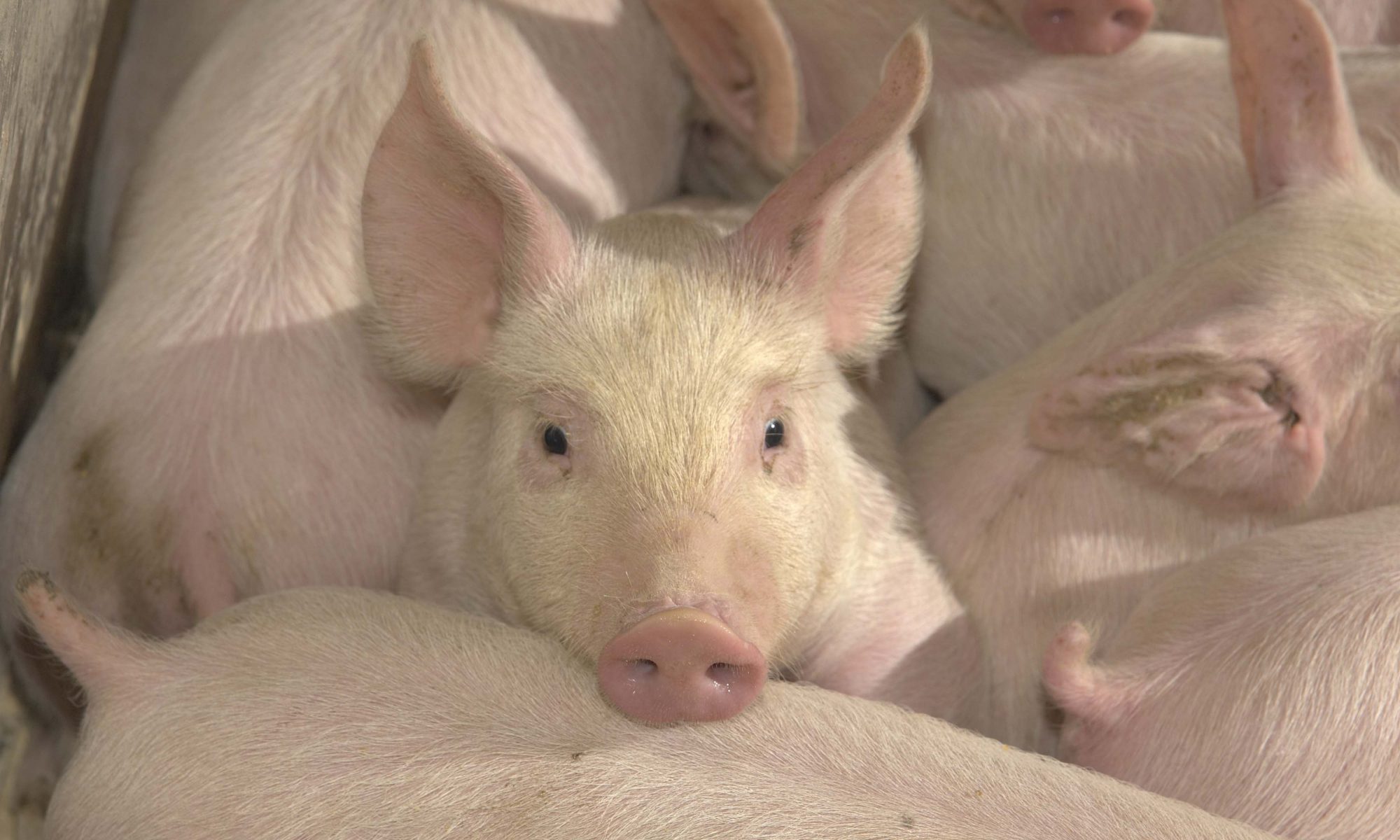Contents
Originally published as a National Pork Board/ American Meat Science Association Fact Sheet.
Author:
Dennis Burson, University of Nebraska
Reviewer:
Eric Berg, University of Missouri
Introduction
Pork carcass merit is one of three general factors affecting the profitability of the pork industry. Reproductive traits and growth performance are economic keys to the profitability and health of the pork industry, yet carcass value also plays an important role. Most packers recognize differences in carcass product value by paying for desired carcass weight, and lean percentage or grade.
Several methods of pork carcass evaluation are used by the industry to improve productivity and carcass merit and also to realize value differences at the marketplace. Carcass evaluation is also used in competitive events to explore differences in carcass value and to provide a stimulation for industry change. Carcass evaluation can be a used by the industry to make important genetic changes.
In order for the pork industry to take advantage of carcass evaluation programs, the procedures must be practical and reflect value differences. Procedures that give a distorted picture of carcass value will be of little use. Procedures that are too expensive will not be used.
Six procedures for carcass measurement used to establish equations that estimate standardized fat free lean will be described. The equations were developed from carcass cutout research and are spelled out in detail in the Pork Composition and Quality Assessment Procedures by the American Meat Science Association and the National Pork Producers Council (NPPC). The equations estimate Standardized Fat Free Lean weight which can then be expressed as a percent of carcass weight. Standardized Fat Free Lean is an estimate of the weight of lean in the carcass. The data for weight of Standardized Fat Free Lean was determined from the weight of dissected lean soft tissue minus the weight of fat which included lipid, water and protein.
Estimation Procedures
The first procedure, using loin muscle area, is more accurate, but is more difficult to obtain. The second, third, and fourth procedures use measurements that may be available from packer lean buying programs and will give satisfactory results. The fifth and sixth procedures can be used when the live hogs are measured with ultrasound methods. The first procedure allows for evaluation of color, marbling and lean firmness and is desired for comparison of individual carcasses for competitive events.
In all procedures, carcass weight is a critical measurement. If cold carcass weights are used, they should be divided by 0.985 to convert to hot carcass weight. If the carcass is skinned, the weight of skinned carcasses should bedivided by 0.94 to convert to skin on basis. In cases where the carcass has been trimmed, carcass weight should be adjusted to compensate for the trim. If the trim is severe—removal of abscessed jowls or arthritic joints from the shoulder or ham—the carcass should be eliminated from competition.
Procedure 1
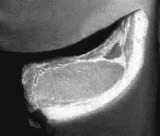
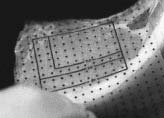
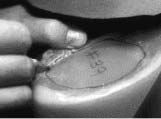

For ribbed carcasses. Hot carcass weight, tenth rib fat thickness over the loin muscle, and loin muscle area at the tenth rib are measured to predict the pounds of standardized fat free lean (SFFL) with procedure 1.
Loin muscle area (Figure 1) can be measured on the hanging carcass by cutting through the backbone and loin muscle between the 10th and 11th ribs perpendicular to the backbone.
The area of the loin muscle may be either measured directly, using a plastic grid (Figure 2) or indirectly by tracing the outline of the loin on acetate paper (Figure 3) for later area determination. Fat thickness, including skin, is measured at the 10th rib over the loin perpendicular to the skin three-fourths of the way out over the loin muscle (Figure 4). Fat measurements on skinned carcasses should be increased by 0.1 inch (or the amount recommended by the processor) for reporting and calculation.
Lb. SFFL=8.588+(0.465 x hot carcass wt., lb.)-(21.896 x 10th rib fat depth, in.)+(3.005 x 10th rib loin muscle area, sq. in.)
Procedure 2

For unribbed carcasses measured with a ruler. Hot carcass weight and last rib carcass backfat thickness are combined in Procedure 2 to estimate standardized fat free leanweight. No carcass cutting is required with this procedure. Last rib carcass backfat thickness is determined by measuring midline fat thickness, including skin, at the last rib (Figure 5). Fat measurements for skinned carcass should be increased by 0.1 inch.
Lb. SFFL=23.568+0.503 x (hot carcass wt., lb.)-21.348 x (last rib backfat thickness, in.)
Procedure 3

For carcasses measured with the Fat-O-Meater. Hot carcass weight, fat depthat the tenth rib, and loin muscle depth between the 3rd and 4th ribs from last rib are the factors needed for predicting fat free lean weight using procedure 3. Fat and loin muscle depth are measured either by use of a light reflecting probe that determines the different tissue layer depths (Figure 6) or manually with the use of a metal probe. No carcass cutting is required for this procedure.
Lb. SFFL=15.31+0.51 x (warm carcass wt., lb.)-31.277 x (last rib backfat thickness, in.)+3.813 x (loin muscle depth, in.)
Procedure 4
For carcasses measured with Animal Ultrasound System (AUS). Packers that use the AUS system of carcass measurement can provide backfat depth and loin muscle depth, and carcass weight to predict fat free lean using procedure 4. The system measures the average fat and muscle depth spanning the last rib to the tenth rib by placement of the ultrasound probe parallel to the midline of the split carcass.
Lb. SFFL=6.783+0.47 x (warm carcass wt., lb.)+4.007 x (average loin muscle depth, in.)-15.745 x (average backfat thickness, in.)
Procedure 5
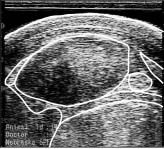
For live hogs measured with ultrasound and using live weight. Pounds of lean can be estimated using procedure 5 for live hogs using ultrasound and a trained technician. Fat depth and loin muscle area at the 10th rib are measured by ultrasound (Figure 7), and live weight isused rather than carcass weight. Sex of the hog is also used in the prediction. Since live weightis influenced by variation in fill, procedure 6 would be preferred if carcass weight can be obtained.
Lb. lean= -0.534+(0.291 x live wt., lbs.)-(16.498 x 10th rib fat depth, in.) +(5.425 x 10th rib loin muscle area, sq. in.)+(0.833 x sex of pig) (barrow=1, gilt=2)
Procedure 6
For live hogs measured with ultrasound and using carcass weight. An alternate procedure with ultrasound uses carcass weight rather than live weight combined with ultrasound measurements on the live hog. This procedure provides less variation in the weight variables and increases the accuracy of prediction.
Lb. lean=5.7769+(0.401 x warm carcass wt., lbs)-(18.838 x 10th rib fat depth, in.)+(4.357 x 10th rib loin muscle area, sq. in.)+(1.006 x sex of pig) (barrow=1, gilt=2)
Application
Percent lean is determined by dividing lean weight by carcass weight. In procedure 5, carcass weight may not be available and percent lean would be determined by dividing lean weight by live weight multiplied by 0.74. Lean quality traits such as color and marbling are also important quality assessments. “NPPC Official Color and Marbling Standards” are available from the National Pork Producers Council, P.O. Box 10306, Des Moines, IA 50306, phone 515-223-2600, http://www.porkscience.org/. More detailed descriptions of both the standardized fat free lean assessment procedures and lean quality evaluation for color and marbling are reported in ”Pork Composition and Quality Assessment Procedures” and standard color photographs for lean color and marbling available from the National Pork Producers Council.
Commercial pork producers find the results of carcass evaluation helpful as a quality control measure. They can compare their pigs with national standards and through competitive events. Breeders find carcass evaluation helpful in identifying superior genetic material for carcass characteristics in their herds.Breeders also find that a carcass evaluation and improvement program in their herd helps assure customers that their breeding stock will produce desirable market hogs.
